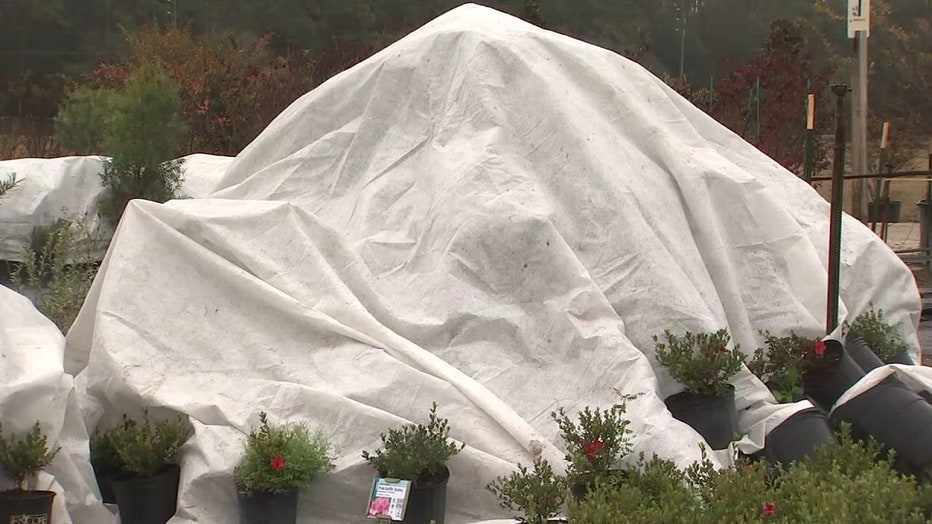Protect your plants: With freeze watch for most of Bay Area, now’s the time to prepare your garden
TAMPA, Fla. - With a freeze watch in effect Sunday morning for counties across central Florida, now is the time to take action to protect your plants.
Winter temperatures in the Sunshine State can get low enough to damage tropical, subtropical, and even sometimes temperate plants, particularly if they're not acclimated to lower temperatures.
On the website for the Institute of Food and Agricultural Sciences at the University of Florida, experts outline some helpful tips for protecting your plants during winter weather.
They say plants become acclimated by gradual decreases in temperature over a period of time. UF researchers say sudden freezes after a period of warm weather often do more damage to plants than a freeze during a period of cold weather.
RELATED: 40 million Americans under winter storm watch ahead of weekend nor'easter
Most plant parts can adapt to cold, but fruits and roots do not develop good cold tolerance. Cold injury to plants in containers is common. According to agriculture experts, you can help your plants survive a freezing spell through acclimatization, protection, and proper post-freeze pruning.
Long before a freeze arrives, taking steps like selecting the right planting site, proper plant nutrition and shading can go a long way. Using windbreaks and irrigation tools can also help.
Coldest air in years will impact Bay Area fishing
Cold air from Canada will push through the Bay Area’s Gulf coast this weekend and have a big effect on our local fisheries, says Captain Dylan Hubbard of Hubbard’s Marina. Fish will migrate into Tampa Bay as far as they can, looking for dark mud to stay warm. Hopefully, they do move, especially the snook, which are more of a tropical species and don’t do well in the prolonged cold. The post-cold front bite should get better mid-week while near shore, especially.
UF researchers note, "While Florida has a general climate, your home landscape will also have its own microclimates—areas that are cooler or warmer, wetter or drier than surrounding areas. Consider microclimates when deciding where to put cold-sensitive plants."
Garden experts say to avoid planting tender plants in a low area where cold air settles.
"Arrange plantings, fences, or other barriers to protect tender plants from cold winds. Make sure the soil has good drainage since poorly drained soils result in weak, shallow roots that are susceptible to cold injury."
Gasparilla parade forecast
FOX 13 meteorologists are expecting this year's Gasparilla parade and invasion to be one of the coldest on record. No rain, but temperatures will struggle to get out of the low 50s and a gusty wind will make it feel even colder. The waters in Tampa Bay will also be rough.
MORE HERE: Gasparilla parade forecast: Wind chill, rough chop in Tampa Bay during pirate invasion
According to researchers at UF, healthy, well-nourished plants tend to tolerate cold temperatures better and recover from injury faster than other plants.
"Be careful though," the IFAS Extension warns on its website, "late fall fertilization can result in a late flush of growth that is more susceptible to cold injury."
Shading can also reduce cold injury during some freezes.
"Areas under tree canopies can reach a higher temperature overnight because the canopy traps heat radiating from the ground. But if you grow a plant that needs full sun in the shade, it will be unhealthy, sparsely foliated, and less tolerant of cold temperatures," the institute's website says.
Fences, buildings, temporary coverings, and adjacent plantings can all serve as windbreaks and protect plants from cold winds, according to experts. "Windbreaks are especially helpful during advective freezes, but do not help during radiational freezes."

Researchers also advise that watering landscape plants before a freeze can help protect them.
"Wet soil will absorb more heat during the day and radiate it during the night. Keep in mind that prolonged saturated soil conditions damage the root systems of most plants."
READ: Nor'easter incoming: Blizzard Warnings issued from Maine to Virginia ahead of heavy snow, winds
Before the freeze, experts recommend moving plants in containers into protected areas where heat can be supplied or trapped. If you must leave containers outdoors, push them together and protect with mulch to reduce heat loss from the container walls.
"Heat radiates from soil surfaces during the night and is mainly lost to the atmosphere unless it is trapped," the University of Florida IFAS Extension says. "Reduce radiant heat loss and protect plant roots by placing mulch around the plants. For perennials, the root system is all that needs to be protected."
Coverings protect more from frost than from extreme cold, researchers say.
"Covers that extend to the ground and do not touch plant foliage can lessen cold injury trapping heat. However, be careful when putting using plastic as a cover because foliage that touches plastic coverings is often injured since the cover actually takes heat away from the plant."
Examples of coverings include cloth sheets, quilts, plastic, or commercial frost cloths. Be sure to remove plastic covers during a sunny day or provide ventilation to keep the air under the cover from heating up too much. Putting a light bulb under a cover is a simple method of providing heat to ornamental plants in the landscape.

